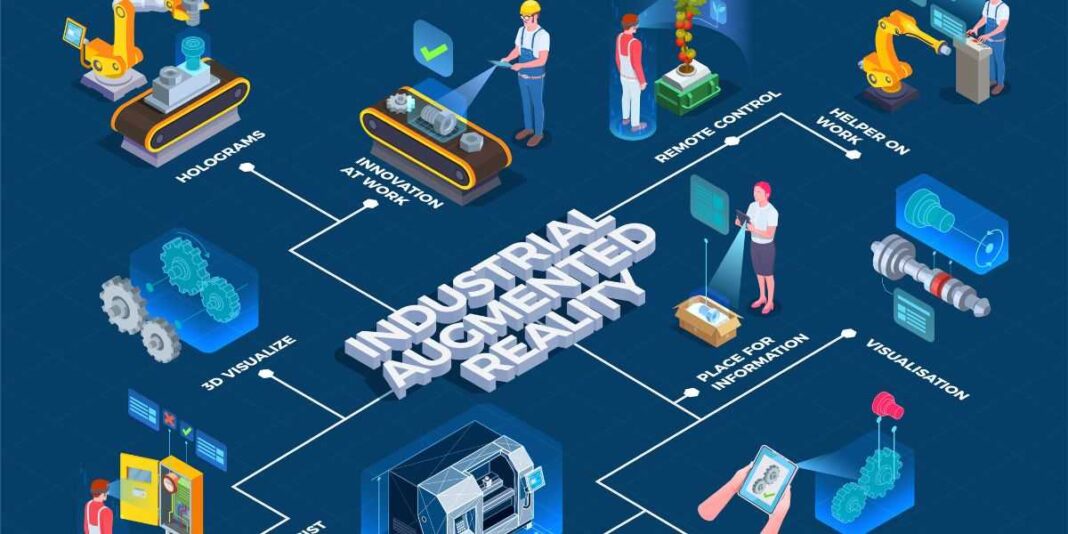AR has the potential to revolutionize the manufacturing and logistics industries by providing new ways to enhance productivity, improve efficiency, and streamline processes. By offering visual and interactive information, AR can help workers perform tasks faster and more accurately, reducing the risk of errors and saving time and resources. AR also has the potential to improve customer experiences by providing a more immersive and interactive experience.
Augmented Reality in Manufacturing
Augmented Reality technology has emerged as a game-changer in the manufacturing industry, providing new and innovative ways to improve processes and increase efficiency. AR enhances the physical world with real-time digital information, offering visual instructions and guidance to workers during the production process. This technology can reduce the risk of errors, improve worker productivity and training, and enhance product design and development. Augmented reality in manufacturing is set to make a major transformation in production processes, offering new and exciting opportunities for growth and improvement.
Benefits of Augmented Reality in manufacturing
AR can help manufacturers improve their operations, including product design, assembly, training, and maintenance. AR can also help designers visualize and test new product designs, making identifying and resolving issues easier before mass production.
- Improved worker productivity and efficiency: AR provides workers with visual instructions and guidance during the production process, reducing the risk of errors and increasing efficiency.
- Reduced risk of errors: With AR, workers have access to real-time information and guidance, reducing the risk of mistakes and improving quality control.
- Enhanced product design and development: AR can help designers visualize and test new product designs, making it easier to identify and resolve any issues before mass production.
- Improved worker training: AR can provide workers with hands-on, interactive training experiences, improving their ability to perform tasks and increasing overall productivity.
- Increased safety on the factory floor: AR can provide workers with real-time information and warnings, reducing the risk of accidents and increasing safety on the factory floor.
- Reduced costs and increased profitability: AR can help manufacturers reduce costs and increase profitability by improving efficiency and reducing the risk of errors.
- Improved customer experiences: By offering a more immersive and interactive experience, AR can help manufacturers improve customer engagement and satisfaction.
Examples of augmented Reality in manufacturing
Some well-known companies have already introduced AR in their manufacturing processes:
1. GE Appliances
GE Appliances’ AR technology provides workers with visual instructions and guidance during the assembly process, reducing the risk of errors and improving efficiency. Technology has proven to be a valuable tool, helping to improve worker productivity and quality control. By using AR, the company can ensure that its products are assembled correctly and consistently, providing customers with high-quality products that meet their needs and expectations.
2. BMW
The company’s AR technology is used to help workers assemble complex components, such as engines and transmissions, with greater accuracy and efficiency. The visual instructions and real-time information provided by the AR technology help workers quickly and easily identify any potential issues, allowing them to make necessary adjustments and resolve any problems in real time.
3. DHL Supply Chain
DHL Supply Chain uses AR to improve its warehouse operations. The company’s AR technology provides workers with visual instructions and guidance, helping them locate and pick items more accurately and efficiently. The technology also helps to reduce the risk of errors, improving quality control and reducing the risk of wrong or lost items. By using AR in its warehouse operations, DHL Supply Chain can improve the overall efficiency of its supply chain, reducing costs and increasing profitability while also improving the overall customer experience.
Augmented Reality in Logistics
Augmented Reality is transforming the logistics industry, providing new and innovative ways to improve warehouse management, delivery processes, customer service, and driver safety. The use of AR in logistics is helping companies to increase efficiency, improve customer satisfaction, and reduce costs. With the rapid advancement of AR technology, it is expected that its use in the logistics industry will continue to grow in the coming years.
Benefits of AR in logistics
AR can improve logistics operations, including warehouse management, delivery, and customer service.
- Improves warehouse management and efficiency: AR provides workers with visual instructions and guidance during the picking and packing process, helping to increase accuracy and reduce the risk of errors. AR also provides real-time information on inventory levels and helps improve the goods flow within the warehouse.
- Enhances delivery and navigation: AR provides delivery drivers with visual instructions and real-time information on the most efficient routes and delivery times, helping to reduce the risk of delays and improve overall delivery times.
- Improves customer service: AR provides customers with real-time information on the location of their deliveries and estimated delivery times, giving them peace of mind and reducing the risk of lost or misdelivered items. AR enhances customer satisfaction and builds brand loyalty through an immersive and interactive experience.
- Increases safety for delivery drivers: AR provides real-time information on traffic conditions, road closures, and other hazards, helping to avoid traffic congestion and reduce the risk of accidents. AR also provides drivers with real-time information on road conditions, improving informed decision-making on the best routes.
Examples of AR in logistics
AR can improve various aspects of logistics operations, and well-known companies are already implementing it in their operations:
1. UPS
UPS is using AR to improve the accuracy and efficiency of its package deliveries. This technology provides delivery drivers with real-time information on the most efficient routes, estimated delivery times, and the current location of packages. This helps drivers to make informed decisions and avoid potential delays, ensuring that packages are delivered on time and in perfect condition.
2. DHL Supply Chain
DHL Supply Chain uses AR to improve warehouse operations and help workers quickly locate items. By using AR, workers can access visual instructions and real-time information on inventory levels, reducing the risk of errors and increasing accuracy in the picking and packing process. AR also helps to improve the flow of goods within the warehouse, reducing congestion and increasing overall efficiency.
3. Amazon
Amazon uses AR to enhance its customer service, allowing customers to preview products in their homes using AR technology. This technology provides customers with a realistic and immersive shopping experience, allowing them to visualize products in their own space before making a purchase. AR also helps customers make informed buying decisions, reducing the risk of returns and improving customer satisfaction and loyalty.
Conclusion
Augmented Reality in manufacturing and logistics has the potential to revolutionize these processes and therefore bring efficient transformation in many industries. By providing workers with visual and interactive information, AR can help enhance productivity, improve efficiency, and streamline processes. Many companies have successfully implemented AR and are expected to play an increasingly important role in these industries in the coming years. If you’re looking to stay ahead of the curve, investing in AR technology is worth considering.
Author Bio:
Siva Subrahmanyam
Siva Subrahmanyam is the SEO analyst and Lead Market Analyst at PlugXR. He has over 7 years experience in the Field of AR, VR and Metaverse industry as a market analyst and digital advertisement of AR, VR and Metaverse. He works with users and developers of PlugXR AR, VR and Metaverse creator platform. Connect with Siva Subrahmanyam at plugxr.com and on LinkedIn.
Also Read: How to Use the Metaverse









![Imginn Instagram Story and Photos Anonymous Viewer Tool [Free] Imginn](https://www.iblogtech.com/wp-content/uploads/2023/09/imginn-150x150.webp)




